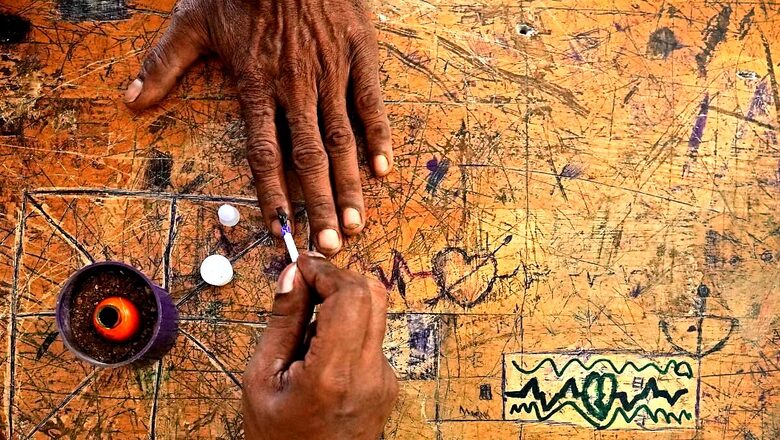
views
Araria, which is going to polls in the third phase of the Lok Sabha elections on May 7, has been identified by the NITI Aayog as having the highest poverty in Bihar. At least 52.07 per cent of the population is poor on the scale of multidimensional poverty set by the public sector think tank.
Araria is one of the 40 Lok Sabha constituencies in Bihar and comprises six assembly segments — Araria (Congress), Narpatganj (BJP), Forbesganj (BJP) Raniganj (JD-U), Jokihat (RJD/AIMIM) and Sikti (BJP). It is presently represented by the BJP’s Pradeep Kumar Singh, who is also the party’s candidate this time. He will be facing Shahnawaz Alam, who has been fielded by the RJD that is a constituent of the opposition INDIA bloc.
BJP maintains healthy lead
The mood on the ground is upbeat in favour of the BJP in Araria, which was a Congress stronghold and has, since 1998, switched between the BJP and RJD. This time, the BJP has reposed its faith in incumbent MP Pradeep Kumar Singh, who defeated RJD’s Sarfaraz Alam by 1.37 lakh votes in the 2019 general elections.
In the last five years, the BJP has consolidated its position in Araria. It now has MLAs in three out of the six assembly segments, while the Congress, JD(U) and RJD have MLAs in one segment each.
The defining factor in nearly all the elections here has been the Muslim-Yadav combination. Together, Muslims and Yadavs form about 59 per cent of the electorate. But, if ground inputs are to be believed, the Yadavs are set to vote for the BJP in large numbers primarily because they realise this is a national election and they are voting for a party to form the government at the Centre.
The women appear to be emerging as one of the biggest proponents of the BJP in this constituency. They point to the increased sense of security and safety they feel under Prime Minister Narendra Modi’s leadership, which allows them to move around without fear of antisocial or criminal elements.
The BJP is pushing ahead with its development plank, coupled with a garnishing of Hindutva to seal its fate in Araria. The construction of the Ram Janmabhoomi Mandir is an oft-repeated “success story” of the BJP.
The BJP’s vote share in Araria has increased since 2014. For example, in 2014, the saffron party could muster just about 2.61 lakh votes and a vote share of 26.8 per cent. Cut to the 2018 bypoll and the BJP’s vote share rose to more than 43 per cent, which roughly translated to 4.47 lakh votes. However, the BJP lost to RJD’s Sarfaraz Alam, who secured about 5.09 lakh votes. A year later, in the 2019 Lok Sabha polls, the BJP got its break in Araria, as it trumped Alam by 1.37 lakh votes. Compared to 2014, the saffron party doubled its vote share in the previous election to about 52 per cent. Therefore, its rise has been steady and natural.
There are some within the BJP who are not particularly impressed with the choice of candidate though. Janardan Yadav, a four-time MLA, has directly accused the party of neglect. He has been associated with the BJP since a time when Araria was not even a district. So, he is definitely an old horse. Separately, there are many senior district leaders in BJP, who have started becoming vocal on problems with the party’s organisational structure.
RJD changes candidate, but faces uphill task
The RJD has played a gamble with Araria this time, and has refused a ticket to Sarfaraz Alam who was expected to be fielded like he was in 2014, 2018 and 2019. Instead, his younger brother Shahnawaz Alam has got the ticket. Both Sarfaraz and Shahnawaz are sons of former union minister Taslimuddin, a tall leader of the RJD. However, following his death, the family’s influence and hold over voters has slipped. For the RJD, this election in many ways will determine whether it remains a relevant political unit in Araria.
Importantly, the RJD has just the Muslim-Yadav caste combination to rely on. Although ground inputs suggest that this caste combination can still hold up in the assembly elections, the “pro-BJP” mood of the public is hard to ignore.
The RJD is being battered by internal tussles. A large group of Sarfaraz Alam’s supporters are angry over the party not making him the candidate. After his ticket was cut, he held a meeting with his supporters in which he burst into tears, a video of which has gone viral. Although he is not contesting as an independent, he has become quite vocal against his brother Shahnawaz.
The enmity between Sarfaraz and Shahnawaz is not new. Previously, Sarfaraz was made the RJD candidate in the Jokihat assembly election in 2020 after the party cancelled the ticket of Shahnawaz, who was the sitting MLA. Subsequently, Asaduddin Owaisi’s AIMIM came to Shahnawaz’s rescue, and allowed him to contest the election on its symbol. Owaisi’s party capitalised on Shahnawaz by heavily promoting him in the entire Seemanchal region. The effect of this was seen among Muslim voters, especially in the Kulhaiya community. Shahnawaz won the election by getting more than 59,000 votes, while his brother Sarfaraz came second with about 52,000 votes.
The RJD appears to believe that the Muslim voters that Shahnawaz Alam has on his side, especially since he was promoted by the AIMIM, will be a plus point for him across Araria. However, on the ground, winds of counter-polarisation among Hindus are blowing strong as well.
Besides, the RJD now believes that the 2018 bypoll win that Sarfaraz secured against the BJP was mostly on the back of a sympathy vote after his father’s death. Meanwhile, revolting from the RJD, state vice-president of the Extremely Backward Cell, Dr Shatrughan Kumar Suman has jumped into the fray as an independent candidate. He is considered to have a strong hold on the voters of his caste, whose numbers are about 3 lakh in the district.
In terms of campaign rhetoric, the RJD is focusing on issues like unemployment, migration, price rise, the overall state of Bihar, which is not promising, and the annual menace of flooding from the Mahananda river and its tributaries. Overall, the party faces a challenge in trying to wrest Araria from the BJP.
Here are the key factors at play in Araria Lok Sabha constituency:
- The Modi factor: The biggest factor to determine who wins Araria will be the “Modi factor”. The sentiment on the ground is that Prime Minister Narendra Modi has delivered on development, even if not up to the mark. Schemes to provide pucca houses, electricity, LPG connections, free ration, health insurance and other basic amenities are galvanising voter sentiment in favour of the BJP.
- Unemployment: There is no escaping the fact that unemployment is perhaps the biggest cause of concern among those either sitting on the fence or are supporters of opposition parties. The youth, which is most affected by unemployment, does appear to be discontent with governments at both state and central levels. Unemployment also causes migration and, in Bihar, the phenomenon of youth migrating to other states and metropolises is particularly pronounced. Not only is this impacting the demography of the state and Araria in particular, but also causing heightened resentment among those who see joblessness as a big issue.
- Flooding: Every year, Araria has to brave floods during the rainy season as incessant rains, especially in Nepal, cause the Mahananda river and its associated rivers to swell up. This wreaks havoc for thousands, with farmers being the worst-hit. In July 2010, Nitish Kumar launched the Mahananda River Basin Project for the fortification of embankments along the river at a cost of Rs 149 crore. He said the initiative will address the problem of flooding. But, 14 years down the line, there has been no solution.
- Shortage of fertilisers: Farmers in Araria have constantly complained about the shortage of fertilisers, and the issue peaked between 2022 and 2023. Farmers in the Seemanchal region, who mostly grow wheat and maize, said fertilisers are being sold on the black market. When the issue was in the limelight, there were allegations that shopkeepers are selling fertilisers at double and triple the market rates.
- Religious polarisation: Singh is Shahnawaz and this is bound to polarise the electorate on religious lines. While the BJP is upbeat with the inauguration of Ram Mandir and how it has galvanised Hindus’ opinion in its favour, the RJD is mostly banking on its tried-and-tested Muslim-Yadav combination. The Yadavs are expected to vote for the BJP, in what will mark another disruption in Bihar’s complex caste-dominated politics.
Voter demographic
Total Voters: 20,14,402
Males: 10,47,698
Females: 9,66,610
SC: 2,61,078 (13.7%)
ST: 26,680 (1.4%)
Rural: ~17,89,435 (93.9%)
Urban: ~1,16,247 (6.1%)
Voter turnout in 2019 polls: 64.8%
Check Lok Sabha Election 2024 Phase 3 Schedule, Key Candidates And Constituencies At News18 Website.



















Comments
0 comment